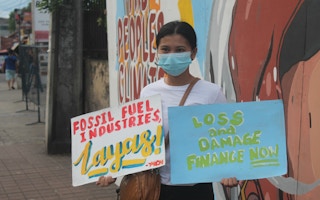In a milestone win for the multi-sectoral environmental defenders of Negros Island in central Philippines, the subsidiary of conglomerate San Miguel Corporation (SMC) has withdrawn from a proposed $320-million liquefied natural gas (LNG) power plant that would have overlooked the region’s biodiversity-rich Tañon Strait along the coast of San Carlos City.
To continue reading, subscribe to Eco‑Business.
There's something for everyone. We offer a range of subscription plans.
- Access our stories and receive our Insights Weekly newsletter with the free EB Member plan.
- Unlock unlimited access to our content and archive with EB Circle.
- Publish your content with EB Premium.
SMC’s Resilience Energy Development Inc. (REDI) has rescinded and will “no longer pursue” its Environmental Compliance Certificate (ECC) application for the 300-megawatt (MW) LNG facility, confirmed Environmental Management Bureau Region 6 director William Cuñado in a letter addressed to Avril de Torres, deputy executive director of the nongovernment organisation Center for Energy, Ecology, and Development (CEED).
“This is a victory for Negrosanons, who have made their voice clear that they preferred renewable energy to LNG in sourcing their power for the island,” Torres announced, welcoming the decision. “Although LNG is considered a ‘transition fuel’ by some, it is clearly unnecessary for Negros, which boasts extensive renewable energy facilities.”
“[We] live for small revolutions,” said Youth For Climate Hope founding member Maria Jaya, who has been at Sharm El-Sheikh, Egypt the last two weeks as a youth delegate to the COP27 UN summit.
“After several months of movement-building and lobbying against the gas plant – led by the strong intersectional and intergenerational communities in our province, with the support of [our] allied organisations, we [have] won,” she continued.
Youth For Climate Hope, alongside Bukluran ng mga Manggawang Pilipino-Negros, Konsyumer-Negros, Sanlakas, the Philippine Movement for Climate Justice and other local stakeholders and organisations gathered for a People’s Climate Strike in Bacolod City, Negros Occidental last week to coincide with demonstrations on the final days of COP27.
Exposure
The proposed facility and its adjacent on-shore LNG terminal had previously been targeted to begin construction on a 49-hectare property facing the Tañon Strait in the San Carlos City Ecozone by the third quarter of 2022.
“Is it worth exposing the Tañon Strait to disturbance and pollution? We have too many questions surrounding this project, which make it harder to make sense of why we can’t just focus on further developing the renewable energy resources we already have,” said Grid Alila of Konsyumer Negros in a statement earlier this year.
With an area of 5,182 square kilometres, the Tañon Strait Protected Seascape is the largest marine protected area (MPA) in the Philippines, lying between the islands of Negros and Cebu in the Philippines’ Visayas region. It is the habitat of some 14 protected whales and dolphins, including whale sharks and the elusive dwarf sperm whale.
Renewable hub
“I’d like to understand why we are seeking to add a fossil fuel-powered plant here on an island that is teeming with renewable power,” said clean energy coalition REpower Negros convenor San Carlos Bishop Gerry Alminaza, who had also penned a letter to SMC president and oil magnate Ramon Ang, calling for “genuine commitment to clean energy.”
A predominantly agricultural region, Negros Island has risen as the country’s burgeoning renewable energy hub in the last decade, largely due to the geothermal potential of Mount Kanlaon and the dormant volcanoes of the Cuernos de Negros mountain range.
Even before the Department of Energy issued a moratorium on new coal-fired power plants in 2020, Negros Island was the first region in the Philippines to ban coal-based power projects entirely.
In March 2018, the local government of Negros Oriental signed an executive order declaring the province a haven of clean energy. Their counterparts in Negros Occidental would follow suit soon after in early 2019, proclaiming the province as wholly “coal-free”.
“
We the youth have been left out of the equation in determining the energy policy of this country. The continued use of fossil fuels will affect us economically in the form of high electricity prices, and environmentally in the form of severe climate change.
Krishna Ariola, founding convenor, Youth for Climate Hope
Earlier this year, the provincial government of Negros Oriental doubled down on their resolve by adopting a Renewable Energy Code ordinance, incentivising clean energy and luring sustainable investors to the region through carbon credits.
“Negros is the centre of renewable energy in the country, and we hope that the rest of the Philippines will follow its lead in saying no to fossil fuels and accelerating the adoption of more affordable and sustainable renewable energy,” added Alminaza.
Youth activism
“We the youth have been left out of the equation in determining the energy policy of this country. The continued use of fossil fuels will affect us economically in the form of high electricity prices, and environmentally in the form of severe climate change,” reflected Krishna Ariola also of Youth for Climate Hope.
“We hope that this development, the third such application by SMC after the proposed LNG projects in Leyte and Cebu, will be the start of a trend against further development of LNG in the country,” she continued.
Reflecting on her time at COP27, Jaya, on the other hand, shared that she has been inspired by her fellow youth activists from around the world, most of whom “demand for nothing less than climate justice with no false solutions”.
“We believe that there can be no climate justice without human rights. We demand an immediate phaseout of fossil fuels, a just transition to renewable energy, and a loss and damage finance facility. We demand protection for environmental and human rights defenders everywhere. We demand to have power over decisions that will affect us the most – the youth and the historically oppressed,” Jaya concluded.








